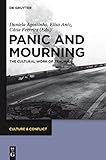Panic and Mourning : The Cultural Work of Trauma / ed. by Daniela Agostinho, Elisa Antz, Cátia Ferreira.
Material type: TextSeries: Culture & Conflict ; 1Publisher: Berlin ; Boston : De Gruyter, [2012]Copyright date: ©2012Description: 1 online resource (285 p.)Content type:
TextSeries: Culture & Conflict ; 1Publisher: Berlin ; Boston : De Gruyter, [2012]Copyright date: ©2012Description: 1 online resource (285 p.)Content type: - 9783110283099
- 9783110283143
- 809/.93353 23
- online - DeGruyter
- Issued also in print.
| Item type | Current library | Call number | URL | Status | Notes | Barcode | |
|---|---|---|---|---|---|---|---|
 eBook
eBook
|
Biblioteca "Angelicum" Pont. Univ. S.Tommaso d'Aquino Nuvola online | online - DeGruyter (Browse shelf(Opens below)) | Online access | Not for loan (Accesso limitato) | Accesso per gli utenti autorizzati / Access for authorized users | (dgr)9783110283143 |
Frontmatter -- Acknowledgements -- Contents -- Introduction -- I. Literary negotiations -- A Culture of Fear: Panic, Mourning, Testimony, and the Question of Representation -- Mourning, Melancholia and Morality: W. G. Sebald’s German-Jewish Narratives -- Nostalgias and Mourning: The Nation in the Serbian Journal The Spring (1992–1996) -- Negotiating Loss and Betrayal: Melancholic Ethics and Narrative Agency in Fae Myenne Ng’s Bone and Steer Toward Rock -- Melancholic Violence and the Spectre of Failed Ideals in Gillo Pontecorvo’s The Battle of Algiers and Yasmina Khadra’s Wolf Dreams -- II. Visual resonances -- Odysseus, Rowing -- (Un-)Framing Triumph and Trauma: Visibility, Gender and Liberation through the Soviet Gaze -- The Banality of Trauma: Globalisation, Migrant Labor, and Nostalgia in Fruit Chan’s Durian Durian -- Evocations of the Unspeakable: Trauma, Silence and Mourning in Contemporary Chinese Art -- “Animism, Magic and the Omnipotence of Thought”: Ritualistic Artefacts and Mourning Mediation in Imperial China -- III. (Re-)mediated affects and performances -- Affective Spaces -- Catastrophes in Sight and Sound -- From Panic to Mourning: 9/11 and the Need for Spectacle -- Stage, Performance, Media Event: the National Commemoration of the Second World War in the Netherlands -- No Fun: Mourning the Loss of Tragedy in Contemporary Performance Art -- Notes on the Editors -- Notes on Contributors
restricted access online access with authorization star
http://purl.org/coar/access_right/c_16ec
‘Panic’ and ‘mourning’ are two pivotal constructs that often emerge and interplay under circumstances of conflict, violence, crisis, and catastrophe, both natural and man-made. Whereas panic tends to crop up during the experience of violent events, mourning, on the other hand, relates to the aftermath of a brutal disruption and to the way humans try to make sense of it retrospectively. Conversely, violent events can leave a thread of panic in their aftermath, while mourning can be unsettled, interrupted or even refuelled by another catastrophic incident. From an international and inter-disciplinary outlook, this volume wishes to address questions at the interface of panic and mourning and their impact on practices in literature, media, and the arts. Since violent events take place within cultures that will draw from their traditions, memories and systems of beliefs in order to process them, the authors of this book aim precisely at discussing the effects of calamity upon the cultural structure and the way literary, artistic and media practices not only reproduce individual and collective anxieties but also generate knowledge and reshape the cultural formation within which they emerge.
Issued also in print.
Mode of access: Internet via World Wide Web.
In English.
Description based on online resource; title from PDF title page (publisher's Web site, viewed 28. Feb 2023)


